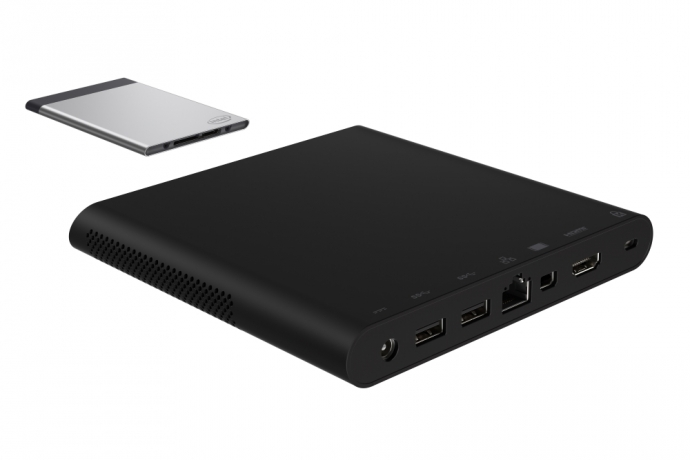Intel's Compute Card is Dead, But This Bad Idea Won't Die
It was an idea ahead of its time, if its time were 2005: Build a tiny desktop PC that fits into your pocket and only works when you plug it into the appropriate dock. Businesses, schools and even hospitals can then provide a series of dumb workstations where users can plug in the tiny PCs. Appliance makers can use these PCs to power their smart TVs and refrigerators and then, when faster versions come out, users can upgrade their washing machines by swapping out a small card or stick.
Unfortunately, both of these highly-touted use cases don’t make any sense in an era of cloud computing and ubiquitous cellular connectivity. No doubt that’s why Intel has come to its senses and discontinued its Compute Card. The only one crying over the death of this credit-card sized PC is NexDock, a small company that planned to build a laptop you could power with a Compute Card. Everyone else seems to have forgotten this product even existed.
Upgradeable Appliances?
In theory, it would be nice to give your connected refrigerator a performance boost, but in practice, there’s no incentive for manufacturers to support this functionality or consumers to take advantage of it. Appliance makers do push out software updates, but getting a fresh UI for your TV’s built-in streaming box is no reason to change its CPU.
Supporting a computer upgrade would be a nightmare for appliance vendors. Does LG really want to get a ton of phone calls asking why your air conditioner won’t boot after you’ve swapped out its compute module? Do consumers really want to spend $200 or more for that upgrade? And wouldn’t vendors rather just sell you a new refrigerator than help you improve the one you already paid them for?
Physically Secure Computing?
At first blush, the idea of a physically secure computer seems to make sense. If you keep the whole computer in your pocket and then plug it in to a docking station when you’re using it, all of the software and data goes with you when you leave. You can even carry different modules for different purposes: work and play, for example.
And Intel was hardly the first company to build a tiny desktop that you could take with you. For example, FXI, a now-defunct Norwegian company, introduced its Cotton Candy computer-on-a-stick way back in 2011. Back then, the company touted its product’s ability to keep your data secure when you walk into an internet cafe or hotel business center.
At around the same time the Cotton Candy came out, a generation of inexpensive stick PCs with Android or Linux released and then, eventually, we started seeing Windows sticks, including Intel’s own Compute Stick. You can still buy these products, but today their small size is their selling point, not their ability to provide a secure environment. If you’re making a digital sign or a kiosk, these space and power-saving devices are still useful in 2019.
Get Tom's Hardware's best news and in-depth reviews, straight to your inbox.
In 2015, Kangaroo, a division of the InFocus, came out with the Mobile Desktop, a portable mini PC with a built-in battery and the ability to output to a tablet. In 2016, Kangaroo came out with a notebook that had a removable module you could pop in and out of the side. Neither of those products took off and Kangaroo is no more.
Then, in 2017, Intel unveiled the Compute Card and, because team blue was behind it, that modular PC looked like it actually had a shot to catch on. At a demo that year, the company brought in partners like LG, Dell and HP who promised to develop devices that depended on the cards.
But when you really think about it, these portable desktops don’t really help with security at all. People have portable computers that keep their data secure; they’re called laptops and they don’t require a dock, because they have a screen and keyboard built in. And, if you need something that fits in your pocket, most people already have one in the form of a phone that has 4G connectivity.
In a world where most people don’t have lightweight mobile devices and therefore use internet cafes or hotel computers when they travel, a portable compute module brings security. Unfortunately for Intel, Kangaroo, FXI and many others, that world ended when smartphones and laptops became affordable and portable enough for mainstream users back in 2008 or 2009.
With these kinds of inherent problems, it’s a wonder that the Compute Card ever came out in the first place. The question isn’t why it failed, but why companies keep tilting at windmills with a concept that doesn’t make sense in the 2010s and beyond.
Note: As with all of our op-eds, the opinions expressed here belong to the writer alone and not Tom's Hardware as a team.
Avram Piltch is Managing Editor: Special Projects. When he's not playing with the latest gadgets at work or putting on VR helmets at trade shows, you'll find him rooting his phone, taking apart his PC, or coding plugins. With his technical knowledge and passion for testing, Avram developed many real-world benchmarks, including our laptop battery test.


